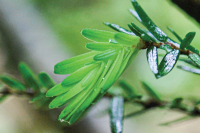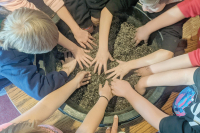The countries of Folkmoot USA
 Japan: Quichar Paradise
Japan: Quichar Paradise
The name Quichar Paradise means “Be Happy Anytime.” This performing group is from Tokyo, Japan, but represent dance of the Okinawa region. The group has participated in numerous folklore festivals including Hohhot Inner Mongolia in China, Yilan International Children’s Folklore and Folkgame (YICF), and the 21st International Folklore Festival VARNA.
Their dances tell of many folklore tales and beliefs such as tragic love stories, harvest celebrations and driving out evil spirits. Many of the dances represent cultural expression from over 400 years ago. One performance is the famous dance of the ancient Okinawan Royal Court where performers wear big hats called hanagasa and hold castanets made from bamboo. They play traditional instruments to accompany their performances: the Shinobue (bamboo flute), Kane (bell), Parlanqoo (small drum), Shime-daiko (medium drum), O-daiko (big drum) and Sanshin (similar to a banjo). The costumes worn for their dances include traditional old-style Kimonos, formal wear and Uchikake: a yellow based colorful gown with tropical flowers and birds.
Canada: Ena Sutton Highland Dancers of Winnipeg
Ena Sutton Highland Dancers of Winnipeg is a Scottish Highland dance group based in Canada.
The Ena Sutton company formed in 1965 and have been delighting audiences of all ages for more than 30 years. Their goal is to foster appreciation of Scottish heritage through the performance of traditional and non-traditional highland dances while performing on a social level rather than a competitive one.
The dancers radiate their joy and love of highland dance even when they are concentrating all their skill and energy on these elegant and vigorous dances. Live musicians accompany the Ena Sutton Highland Dancers on the bagpipes and bodhran. With a swirl of plaid and the unique sound of bagpipes, the Ena Sutton Highland Dancers will bring you the timeless pleasures and talents of Scottish dance.
France: Lous Gouyats De L’Adou
Lous Gouyats De L’Adou, “young people of the Adour” is a performing group from France formed in 1965. Members perform in order to revive and preserve the traditions of folklore in their region.
Perhaps best known for the stilts used in performances, this presentation represents how the “Waders” used to negotiate the swampy, flat lands where they cared for flocks of sheep.
The Gouyats have participated in more than 2,500 performances, 100 international folk festivals and in 18 different countries. Their repertoire includes 30 traditional dances from south of the Ardour and Grande Lande.
The clothing used for performances include for boys: berets, large red or black cummerbunds, loose shirts and calves wrapped in ancient “trabucs” wool. Waders on stilts wear sheepskin coats. Girls are attired in very simple large striped skirts, aprons with soft colors and pretty shimmering shawls.
Mexico: El Ballet Folklórico Tradiciones ESMDM
El Ballet Folklórico Tradiciones represent the School of Music and Dance in Monterrey, Nuevo León, Mexico. The dance group was initiated in 1987 with the objective of promoting and preserving Mexican dance in its most faithful and true representation. The ballet is composed of 34 performers, mostly ESMDM graduates, and eight musicians under the direction of the professors Silvia Gil and Rene Garza.
Tradiciones has offered numerous performances in Mexico and abroad, performing in countries like the USA, Italy, Spain Portugal, Croatia, and Canada. They are proud to bring joy through their dance and culture to as many people as possible.
Slovakia: Zobor University Folk Ensemble
The University Folk Ensemble Zobor comes from the oldest town in the Slovak Republic, Nitra, first settled in 828 AD. Zobor is the name of the hill above the town of Nitra.
Founded in 1956, Zobor is one of the oldest folklore ensembles in Slovakia. Winners of multiple awards for choreography and musical arrangements, they have performed countless shows in Slovakia and 20 other countries throughout the world.
Zobor’s dances are about ordinary country life, where poverty made life short and painful. Love, work and war are three main themes you can find in Slovak folklore as well as life’s events: marriage, birth and death. Life was very difficult, therefore the Slovak people tried to make it easier by singing anytime they could.
Every second year the Zobor group organizes the CIOFF® International Festival of Academic Folk Ensembles, called Academic Nitra. Approximately 900 people from all over the world attend their festival.
Thailand: Chanthaburi Folk Dance Group
The Chanthaburi Folk Dance group is from Chanthaburi, Thailand, near the capital city of Bangkok. Performers of the group are folk dance experts and specially selected students.
This group has won numerous awards and been honored by Her Royal Highness, Princess Maha Chakri Sirindhorn, for a Thai musical performance competition. Chanthaburi has participated in international and folklore festivals in Mexico, Germany, Switzerland, Italy, Turkey, South Korea and Australia as well as a World Music competition in the Netherlands.
Signature Thai dance elements include movements of the body, arms, hands and legs to imitate the natural movements of birds and animals. Traditional costumes are often constructed of silk fabric which may be embroidered. Dancers of the north and south of Thailand usually attach long, curved bronze “fingernails,” which accentuate the fluid, sensual movements of the hands.
Martinique: Le Grand Ballet de Martinique
Le Grand Ballet de Martinique was created in 1946. The dances and songs of Grand Ballet de Martinique evoke the distant past of the French West Indies.
Comprised of about 30 musicians and dancers dressed in traditional costumes, Le Grand Ballet de Martinique perform with the “old school” rhythms of beguine and mazurka. Performances convey the joys and sorrows in a story of ancient times and how slavery led to modern Martinique.
Energetic and entertaining, the performers of Le Grand Ballet de Martinique provide an interesting cultural view into the historic island of Martinique.
Poland: Wici Song and Dance Company
The Wici Song and Dance Company was organized in 1972 in Chicago. Its mission is to promote Polish culture through song, dance, and music.
Wici has carried the traditions of their ancestors through with their authentic costumes and original choreography. All members of the company perform without any compensation or monetary reward. Over 8,000 young people and adults have participated in the group’s activities since its origin.
Wici is comprised of two groups totaling morethan 300 dancers, musicians, and artists. The group wears hand-made costumes imported from Poland, including colorful men’s and women’s attire made from wool, velvet, and silk, some of which are priceless original handicrafts.
Wici has traveled and performed at venues all over the world including Canada, Italy, Poland, the Caribbean, and Mexico. Several years ago, it started exploring American folklore and music including country western and clogging. One of its new dances comes from the Appalachian region.









